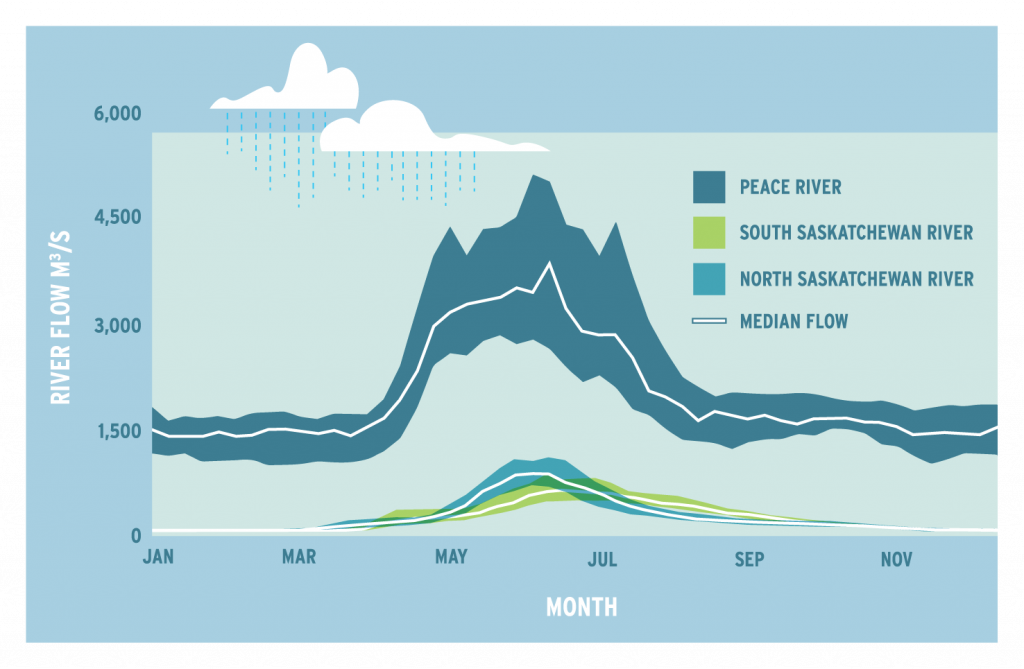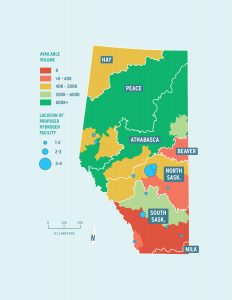Water for Alberta’s Hydrogen Economy
The information below is drawn from a research report published in June 2023 by WaterSMART Solutions. This report, commissioned by Alberta Innovates, highlights the importance of water in the development of Alberta’s hydrogen economy (WaterSMART Solutions Ltd., 2023). Hydrogen production can have a similar level of water consumption to gasoline and diesel fuels, but the locations where new hydrogen facilities are proposed in Alberta could face water insecurity (Lampert, Cai, & Elgowainy, 2016). To date, limited research has been published regarding this topic, especially for water stressed regions that have visions for large scale hydrogen production. WaterSMART’s investigation concluded that water resources should be carefully considered in Alberta when planning the transition to a hydrogen future, because water use for hydrogen will compete with other water uses, such as for food, people, and the economy. As of the writing of this post, Alberta is facing one of the most severe droughts it has ever seen (see the Canadian Drought Monitor for more information), and this has the potential to impact Alberta’s people, industry, and environment. Our water supply should not be taken for granted.
Alberta has committed to reaching net zero emissions by 2050 and now must take actionable steps towards achieving this goal (Government of Alberta, 2023). The province is positioned to rapidly advance a hydrogen fuel economy, which has the potential to reduce emissions across many sectors. In addition to its existing uses in oil and gas refining, new hydrogen sources could be used to fuel vehicles and aircraft, heat homes, provide electricity, generate industrial feedstocks like ammonia and methanol, and more. In pursuing emissions reduction and climate change mitigation pathways, it is critical to consider other environmental, social, and economic impacts and trade-offs within the context of the water-energy-food nexus. One of the most important considerations, and the focus of this post, is Alberta’s shared, and finite, water resources.

Figure 1: Summary of different hydrogen production technologies (ATR, SMR, Pyrolysis, and Electrolysis), all of which are discussed below, proposed in Alberta.
Water Supply across Alberta
The amount of water available for use varies regionally, seasonally, and year over year. There are regulations in place within Alberta that ensure that the freshwater flowing in Alberta’s lakes and rivers is shared between the environment, people, and industry. The main form of regulation is through water licences, which provincial regulators issue to water consumers after an application is submitted. Applications can be approved or denied based on local water availability. At certain times of the year, especially in the summer and early fall when all the snow has melted and rainfall is limited, some areas of our province can experience low water levels and even droughts. This occurs more frequently in the southern part of the province, where water is less abundant. During these times, some water users may have their access to water restricted under Alberta’s priority-based allocation system. This lack of water access is a material risk for hydrogen producers, and it is therefore critical to examine the current and future water availability in locations proposed for hydrogen development.
The following graph demonstrates how the streamflow changes seasonally and annually in three major rivers in Alberta. Keeping in mind that this streamflow must be shared among people, the environment, and other industry, this figure demonstrates how important it is to strategically locate operations with high water demands. In some places, the river may simply not have the necessary supply for a high demand.

Figure 2: Visualization of river flows in different regions of Alberta, which vary seasonally and annually. The Peace River is in northern Alberta, while the North and South Saskatchewan are in the south.
Water Demand for Hydrogen Production
Hydrogen can be produced using a variety of techniques, several of which have been proposed in Alberta, and all of which require water. The main technologies are:
- Steam Methane Reforming (SMR)
- Autothermal Reforming (ATR)
- Electrolysis
- Pyrolysis
Each hydrogen production technology has different efficiencies and water consumption rates, which are detailed in the table below. Importantly, the theoretically achievable water consumption rate is lower than what is actually achievable. This is because of real world process inefficiencies as well as the need for water in plant cooling processes and high-quality water input to the process.

Steam Methane Reforming (SMR)
SMR is currently the most widely used technology for hydrogen production. While there are many different forms of SMR that use various catalysts and gaseous mixtures, the underlying method uses high temperatures to reduce methane (CH4) with water (H2O) into hydrogen (H2) and carbon dioxide (CO2). Many proposed SMR projects in Alberta have committed to capturing the CO2 with carbon capture technologies to reduce the emissions intensity of the hydrogen.
Autothermal Reforming (ATR)
Emerging as a competitor to SMR is ATR, which uses a similar process to SMR combined with partial oxidation. The main difference is that oxygen is also used along with the steam-reforming reaction to oxidize the methane into hydrogen. Overall, less heat and water are required. Carbon dioxide can also be captured from the ATR process, and this is more easily done than for SMRs.
Electrolysis
Water Electrolysis is fundamentally the splitting of water into hydrogen and oxygen. Electrolysis is a well-established technology and can be combined with renewable sources of electricity to produce hydrogen that does not directly require any hydrocarbon-based fuels. The reaction for water electrolysis is the exact opposite of combusting hydrogen. The main drawback of water electrolysis is the large amount of energy needed to split the water. If the energy is not derived from renewables, it will still be tied to carbon emissions. Electrolysis requires significant cooling, which is typically from evaporative cooling [2]. In addition, the process water for electrolysis must be of a high quality. Depending on the raw water quality, treatment can be an expensive and water intensive process.
Pyrolysis
Methane pyrolysis is the thermal decomposition, or breaking down, of methane using energy. Methane is split directly into hydrogen and carbon. Because solid carbon (C) is the only byproduct and is more easily manageable than CO2, proponents of pyrolysis argue it is a cleaner alternative for producing hydrogen, especially if renewable electricity is used to generate the heat needed for pyrolysis. While water is not a direct input, water may be required for cooling and catalyst reformation depending on the specific methane pyrolysis technology.
Table 1: Summary of theoretical vs actual water intensity of different hydrogen production technologies (WaterSMART Solutions Ltd., 2023).
| Technology | Litres of water consumed per kg of hydrogen produced | % of proposed hydrogen production in Alberta as of 2023 | |
| Theoretical | Actual | ||
| ATR | 3.9 | 4.8 – 21.7 | 69% |
| SMR | 4.5 | 5.5 – 25.0 | 9% |
| Electrolysis | 9 | 10 – 45.0 | 22% |
| Pyrolysis | 0 | 1.0 – 16.3 | 1% |
These processes are complex, and it is difficult to estimate the exact water requirements of proposed hydrogen facilities. Therefore, it is important that hydrogen project developers perform detailed analyses early in the planning stages to determine their water demands and the water available within the watersheds where they wish to operate.
Comparing Water Supply to Demand
Depending on where hydrogen facilities are built and which production technology is used, new hydrogen production could have varying impacts on the local watershed and could face different levels of risk in terms of water shortage. Water is a local issue, and it cannot easily be transferred between major watersheds under Alberta’s regulatory system. In Alberta, 80% of the freshwater is in the North, while 80% of the population lives in the South. Even if the regulations changed, the cost would likely be too great to make transportation between basins feasible.

Figure 3: Heat map of Alberta, in terms of water availability, before new Hydrogen production facilities begin operations.
As you can see in Figure 3 above, many of the watersheds in which new hydrogen production is proposed already have limited water available for new uses. Some locations, such as in the South Saskatchewan, new water licenses cannot be applied for because the available water has already been allocated. As Figure 4 below shows, in a dry year, basins such as the North Saskatchewan, could become stressed due to the water demand from new hydrogen facilities.

Figure 4: Heat map of Alberta, in terms of water availability, after new Hydrogen production facilities begin operations.
Climate Change Impacts
Temperature and precipitation trends demonstrate that measurable changes are already being experienced in Alberta (University of Lethbridge , 2020). For example, between 1951 and 2017 data shows that average winter temperatures in the province have already warmed 4 – 5 °C in southern Alberta and 6 – 7 °C in northern Alberta (University of Lethbridge , 2020). Continuing changes in both temperature and precipitation are driving changes in water availability across the province.
Overall, the temperature in Alberta is expected to increase. Particularly important from a hydrology perspective is that winter temperatures are projected to increase more than summer and fall temperatures, especially in the northern part of the province (WaterSMART Solutions Ltd., 2020). Increasing winter temperatures may mean more winter precipitation falls as rain, spring snowmelt occurs earlier, and snow will intermittently melt during the winter. These changes are likely to impact seasonal water availability patterns. Warmer temperatures are also projected in the summer, which will increase the rate of evaporation and evapotranspiration and may consequently reduce the available surface water and soil moisture (WaterSMART Solutions Ltd., 2020). Simultaneously, higher ambient temperatures are likely to increase the demand for water from facilities using evaporative cooling, potentially exacerbating warm-weather water availability challenges.
The water supply risks associated with climate change are implicitly considered within this research.
Conclusion
Although new hydrogen production, and its associated water consumption, may strain existing water supplies in some parts of Alberta, it must be noted that hydrogen production itself is not an inherent threat to Alberta’s water. Other new water demands associated with municipal, agricultural, and industrial development will also emerge in the future and could have the same water supply impacts as hydrogen in cases where the volumes demanded are the same. Additionally, producers that already have water licences secured do not necessarily face the same risks as those requiring new licences to operate in the future.
Whenever a new demand is placed on a finite resource, critical thought must be applied to fully understand the trade-offs and risks. In the case of new demand on Alberta’s water supply, especially on the scale of the proposed hydrogen production in the southern basins, water may be a limiting factor for production. The new demands could also limit the opportunity to support other water uses in the future. In the face of uncertainty surrounding climate change and changing precipitation patterns, our shared and finite water resources must be strategically managed to ensure Alberta’s people, economy, and environment are well positioned for the future.
Sources
[i] Government of Alberta. (2023, April 19). Emissions Reduction and Energy Development Plan. Retrieved from https://www.alberta.ca/emissions-reduction-and-energy-development-plan
[ii] Lampert, D. J., Cai, H., & Elgowainy, A. (2016, 01 12). Wells to wheels: water consumption for transportation fuels in the United States. Retrieved from https://www.osti.gov/biblio/1392949
[iii] University of Lethbridge . (2020, January 6). Interactive website shows Albertans how the climate is changing in their backyard. Retrieved from https://www.ulethbridge.ca/unews/article/interactive-website-shows-albertans-how-climate-changing-their-backyard#.XhNj5-t7l0A
[iv] WaterSMART Solutions Ltd. (2020). Appendix B: Hydrology Baseline Summary Report, appended to the Prairies and Land Management Strategy.
[v] WaterSMART Solutions Ltd. (2023, June 9). Study of Water Impacts of Hydrogen Development in Alberta . Retrieved from https://watersmartsolutions.ca/knowledge-base/study-of-water-impacts-of-hydrogen-development-in-alberta-2023/
